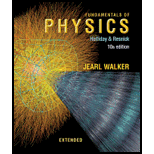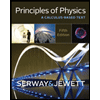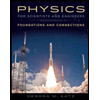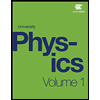
Fundamentals of Physics Extended
10th Edition
ISBN: 9781118230725
Author: David Halliday, Robert Resnick, Jearl Walker
Publisher: Wiley, John & Sons, Incorporated
expand_more
expand_more
format_list_bulleted
Concept explainers
Textbook Question
Chapter 16, Problem 87P
A wave on a string is described by
y(x, t) = 15.0 sin(πx/8 − 4πt),
where x and y are in centimeters and t is in seconds. (a) What is the transverse speed for a point on the string at x = 6.00 cm when t = 0.250 s? (b) What is the maximum transverse speed of any point on the siring? (c) What is the magnitude of the transverse acceleration for a point on the string at x = 6.00 cm when t = 0.250 s? (d) What is the magnitude of the maximum transverse acceleration for any point on the string?
Expert Solution & Answer
Want to see the full answer?
Check out a sample textbook solution
Chapter 16 Solutions
Fundamentals of Physics Extended
Ch. 16 - Prob. 1QCh. 16 - Prob. 2QCh. 16 - Prob. 3QCh. 16 - Prob. 4QCh. 16 - Prob. 5QCh. 16 - The amplitudes and phase differences for four...Ch. 16 - Prob. 7QCh. 16 - a If a standing wave on a siring is given by y't =...Ch. 16 - Prob. 9QCh. 16 - If you set up the seventh harmonic on a string, a...
Ch. 16 - Prob. 11QCh. 16 - If a wave yx, t = 6.0mm sinkx 600 rad/st ...Ch. 16 - Prob. 2PCh. 16 - A wave has an angular frequency of 110 rad/s and a...Ch. 16 - Prob. 4PCh. 16 - A sinusoidal wave travels along a string. The time...Ch. 16 - Prob. 6PCh. 16 - A transverse sinusoidal wave is moving along a...Ch. 16 - Prob. 8PCh. 16 - Prob. 9PCh. 16 - The equation of a transverse wave traveling along...Ch. 16 - Prob. 11PCh. 16 - GO The function yx, t = 15.0 cm cosx 15 t, with x...Ch. 16 - Prob. 13PCh. 16 - The equation of a transverse wave on a string is y...Ch. 16 - Prob. 15PCh. 16 - The speed of a transverse wave on a string is 170...Ch. 16 - The linear density of a string is 1.6 104 kg/m. A...Ch. 16 - Prob. 18PCh. 16 - SSM What is the speed of a transverse wave in a...Ch. 16 - The tension in a wire clamped at both ends is...Ch. 16 - ILW A 100 g wire is held under a tension of 250 N...Ch. 16 - A sinusoidal wave is traveling on a string with...Ch. 16 - SSM ILW A sinusoidal transverse wave is traveling...Ch. 16 - Prob. 24PCh. 16 - A uniform rope of mass m and length L hangs from a...Ch. 16 - A string along which waves can travel is 2.70 m...Ch. 16 - Prob. 27PCh. 16 - Use the wave equation to find the speed of a wave...Ch. 16 - Use the wave equation to find the speed of a wave...Ch. 16 - Use the wave equation to find the speed of a wave...Ch. 16 - Prob. 31PCh. 16 - What phase difference between two identical...Ch. 16 - Prob. 33PCh. 16 - Prob. 34PCh. 16 - SSM Two sinusoidal waves of the same frequency...Ch. 16 - Four waves are to be sent along the same string,...Ch. 16 - GO These two waves travel along the same string:...Ch. 16 - Two sinusoidal waves of the same frequency are to...Ch. 16 - Two sinusoidal waves of the same period, with...Ch. 16 - Two sinusoidal waves with identical wavelengths...Ch. 16 - Prob. 41PCh. 16 - Prob. 42PCh. 16 - SSM WWW What are a the lowest frequency, b the...Ch. 16 - A 125 cm length of string has mass 2.00 g and...Ch. 16 - Prob. 45PCh. 16 - String A is stretched between two clamps separated...Ch. 16 - Prob. 47PCh. 16 - If a transmission line in a cold climate collects...Ch. 16 - Prob. 49PCh. 16 - Prob. 50PCh. 16 - Prob. 51PCh. 16 - A rope, under a tension of 200 N and fixed at both...Ch. 16 - Prob. 53PCh. 16 - Prob. 54PCh. 16 - GO The following two waves are sent in opposite...Ch. 16 - A standing wave pattern on a string is described...Ch. 16 - A generator at one end of a very long string...Ch. 16 - GO In Fig. 16-42, a string, tied to a sinusoidal...Ch. 16 - GO In Fig. 16-43, an aluminum wire, of length L1 =...Ch. 16 - Prob. 60PCh. 16 - Prob. 61PCh. 16 - Prob. 62PCh. 16 - A wave has a speed of 240 m/s and a wavelength of...Ch. 16 - The equation of a transverse wave traveling alone...Ch. 16 - The equation of a transverse wave traveling along...Ch. 16 - Prob. 66PCh. 16 - Prob. 67PCh. 16 - Prob. 68PCh. 16 - Prob. 69PCh. 16 - Prob. 70PCh. 16 - A transverse sinusoidal wave is generated at one...Ch. 16 - Prob. 72PCh. 16 - Prob. 73PCh. 16 - Prob. 74PCh. 16 - a What is the fastest transverse wave that can be...Ch. 16 - A standing wave results from the sum of two...Ch. 16 - Prob. 77PCh. 16 - Prob. 78PCh. 16 - Prob. 79PCh. 16 - When played in a certain manner, the lowest...Ch. 16 - A sinusoidal transverse wave traveling in the...Ch. 16 - Two sinusoidal waves of the same wavelength travel...Ch. 16 - Prob. 83PCh. 16 - Prob. 84PCh. 16 - Prob. 85PCh. 16 - a Write an equation describing a sinusoidal...Ch. 16 - A wave on a string is described by yx, t = 15.0...Ch. 16 - Prob. 88PCh. 16 - Two waves are described by...Ch. 16 - Prob. 90PCh. 16 - SSM In a demonstration, a 1.2 kg horizontal rope...Ch. 16 - Prob. 92PCh. 16 - A traveling wave on a string is described by...Ch. 16 - Prob. 94PCh. 16 - Prob. 95PCh. 16 - Consider a loop in the standing wave created by...
Additional Science Textbook Solutions
Find more solutions based on key concepts
A 1 kg object moves at 0.8crelative to Earth. (a) Calculate the momentum and energy of the object. (b) Determin...
Modern Physics
Explain all answers clearly, with complete sentences and proper essay structure if needed. An asterisk (*) desi...
Cosmic Perspective Fundamentals
Five loops of copper wire of same gauge (crosssectional area). Loops 14 are identical; loop 5 has the same heig...
Tutorials in Introductory Physics
Consider the previous problem and include the fact that Earth has an orbital speed about the Sun of 29.8km/s . ...
University Physics Volume 1
Choose the best answer to each of the following. Explain your reasoning. Whats the best explanation for the loc...
The Cosmic Perspective Fundamentals (2nd Edition)
Do you think these differences in distance between locations at the same latitude in the Northern and Southern ...
Lecture- Tutorials for Introductory Astronomy
Knowledge Booster
Learn more about
Need a deep-dive on the concept behind this application? Look no further. Learn more about this topic, physics and related others by exploring similar questions and additional content below.Similar questions
- The speed of a transverse wave on a string is 300.00 m/s, its wavelength is 0.50 m, and the amplitude is 20.00 cm. How much time is required for a particle on the string to move through a distance of 5.00 km?arrow_forwardA taut rope has a mass of 0.180 kg and a length of 3.60 m. What power must be supplied to the rope so as to generate sinusoidal waves having an amplitude of 0.100 m and a wavelength of 0.500 m and traveling with a speed of 30.0 m/s?arrow_forwardA string with a mass of 0.30 kg has a length of 4.00 m. If the tension in the string is 50.00 N, and a sinusoidal wave with an amplitude of 2.00 cm is induced on the string, what must the frequency be for an average power of 100.00 W?arrow_forward
- A transverse wave on a string is described by the wave function y=0.120sin(8x+4t) where x and y are in meters and t is in seconds. Determine (a) the transverse speed and (b) the transverse acceleration at t = 0.200 s for an element of the string located at x = 1.60 m. What are (c) the wavelength, (d) the period, and (e) the speed of propagation of this wave?arrow_forwardTwo sinusoidal waves are moving through a medium in the positive x-direction, both having amplitudes of 6.00 cm, a wavelength of 4.3 m, and a period of 6.00 s, but one has a phase shift of an angle =0.50 rad. What is the height of the resultant wave at a time t=3.15 s and a position x=0.45 m ?arrow_forwardBy what factor would you have to multiply the tension in a stretched string so as to double the wave speed? Assume the string does not stretch. (a) a factor of 8 (b) a factor of 4 (c) a factor of 2 (d) a factor of 0.5 (e) You could not change the speed by a predictable factor by changing the tension.arrow_forward
- When a standing wave is set up on a string fixed at both ends, which of the following statements is true? (a) The number of nodes is equal to the number of antinodes. (b) The wavelength is equal to the length of the string divided by an integer. (c) The frequency is equal to the number of nodes times the fundamental frequency. (d) The shape of the string at any instant shows a symmetry about the midpoint of the string.arrow_forwardA sound wave in air has a pressure amplitude equal to 4.00 103 Pa. Calculate the displacement amplitude of the wave at a frequency of 10.0 kHz.arrow_forwardA sound wave can be characterized as (a) a transverse wave, (b) a longitudinal wave, (c) a transverse wave or a longitudinal wave, depending on the nature of its source, (d) one that carries no energy, or (e) a wave that does not require a medium to be transmitted from one place to the other.arrow_forward
arrow_back_ios
arrow_forward_ios
Recommended textbooks for you
 Principles of Physics: A Calculus-Based TextPhysicsISBN:9781133104261Author:Raymond A. Serway, John W. JewettPublisher:Cengage Learning
Principles of Physics: A Calculus-Based TextPhysicsISBN:9781133104261Author:Raymond A. Serway, John W. JewettPublisher:Cengage Learning Physics for Scientists and Engineers, Technology ...PhysicsISBN:9781305116399Author:Raymond A. Serway, John W. JewettPublisher:Cengage Learning
Physics for Scientists and Engineers, Technology ...PhysicsISBN:9781305116399Author:Raymond A. Serway, John W. JewettPublisher:Cengage Learning Physics for Scientists and Engineers: Foundations...PhysicsISBN:9781133939146Author:Katz, Debora M.Publisher:Cengage Learning
Physics for Scientists and Engineers: Foundations...PhysicsISBN:9781133939146Author:Katz, Debora M.Publisher:Cengage Learning University Physics Volume 1PhysicsISBN:9781938168277Author:William Moebs, Samuel J. Ling, Jeff SannyPublisher:OpenStax - Rice University
University Physics Volume 1PhysicsISBN:9781938168277Author:William Moebs, Samuel J. Ling, Jeff SannyPublisher:OpenStax - Rice University

Principles of Physics: A Calculus-Based Text
Physics
ISBN:9781133104261
Author:Raymond A. Serway, John W. Jewett
Publisher:Cengage Learning

Physics for Scientists and Engineers, Technology ...
Physics
ISBN:9781305116399
Author:Raymond A. Serway, John W. Jewett
Publisher:Cengage Learning

Physics for Scientists and Engineers: Foundations...
Physics
ISBN:9781133939146
Author:Katz, Debora M.
Publisher:Cengage Learning

University Physics Volume 1
Physics
ISBN:9781938168277
Author:William Moebs, Samuel J. Ling, Jeff Sanny
Publisher:OpenStax - Rice University
What Are Sound Wave Properties? | Physics in Motion; Author: GPB Education;https://www.youtube.com/watch?v=GW6_U553sK8;License: Standard YouTube License, CC-BY